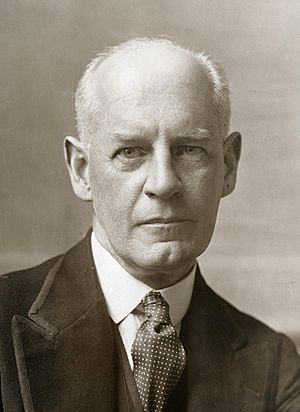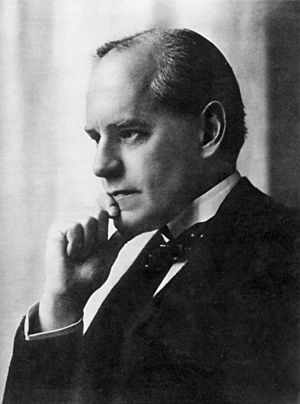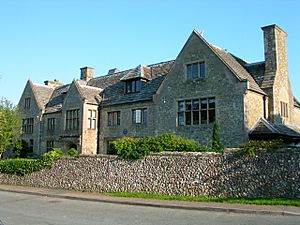John Galsworthy facts for kids
Quick facts for kids
John Galsworthy
|
|
|---|---|
 |
|
| Born | 14 August 1867 Kingston upon Thames, Surrey, England |
| Died | 31 January 1933 (aged 65) Hampstead, London, England |
| Occupation | Writer |
| Citizenship | British |
| Notable awards | Nobel Prize in Literature 1932 |
| Spouse | Ada Galsworthy |
| Signature | |
 |
|
| President of PEN International |
|
| In office October 1921 – October 1933 |
|
| Succeeded by | H. G. Wells |
John Galsworthy (born August 14, 1867 – died January 31, 1933) was a famous English writer. He wrote many novels and plays. His most well-known works include The Forsyte Saga and its follow-up stories. In 1932, he won the important Nobel Prize in Literature for his writing.
Contents
About John Galsworthy's Life
John Galsworthy was born in Kingston Hill, Surrey, England. His family was wealthy and well-known. He went to Harrow and then to New College, Oxford for his education. After college, he studied law and became a lawyer in 1890.
Instead of practicing law, Galsworthy traveled a lot. He helped with his family's shipping business across Europe. During his travels in 1893, he met another future famous writer, Joseph Conrad, in Australia. They became very good friends. In 1905, Galsworthy married Ada Nemesis Pearson Cooper. They lived together until he passed away in 1933. They often stayed at a farmhouse called Wingstone in Devon, which became their second home.
His Writing Career
John Galsworthy started his writing journey in 1897 with a collection of short stories called From the Four Winds. At first, he used the pen name John Sinjohn. He only started using his real name, John Galsworthy, in 1904 with his book The Island Pharisees.
His first successful play was The Silver Box in 1906. That same year, he published The Man of Property, which was the first book in his famous Forsyte Saga series. Even though he wrote both plays and novels, people at the time knew him more for his plays. Like other writers of his time, he often wrote about the class system and other social issues. Two of his well-known plays are Strife (1909) and The Skin Game (1920).
Today, John Galsworthy is best known for his novels, especially The Forsyte Saga. This series tells the story of the Forsyte family and their lives. In these books, Galsworthy explored themes like social class, especially the lives of the upper-middle class. He showed how some people were narrow-minded and focused on owning things. He is seen as one of the first writers of the Edwardian era to question the ideas of society from the earlier Victorian times. He also often wrote about women in unhappy marriages. The character of Irene in The Forsyte Saga was inspired by his wife, Ada Pearson.
Important Causes and Awards
Causes John Galsworthy Supported
Through his writing, Galsworthy supported many important causes. He spoke out for prison reform, which means making prisons better. He also fought for women's rights and animal welfare. He was against censorship, which is when people try to stop others from sharing ideas.
During World War I, Galsworthy supported Britain joining the war to protect Belgium. He even worked as an orderly in a hospital in France. In 1917, he was offered a knighthood by the Prime Minister, but he turned it down. He believed that a writer's true reward comes from writing itself.
Galsworthy cared deeply about animals. He was against the killing of animals and fought for animal rights. He was also a humanitarian, meaning he cared about human well-being. He was against hunting and supported groups that wanted to stop cruel sports involving animals.
Awards and Honours
John Galsworthy was offered a knighthood in 1918, but he refused it. In 1921, he became the first president of PEN International, a group for writers around the world. He was given the Order of Merit in 1929, which is a special award in Britain.
In 1932, he received the Nobel Prize in Literature. He gave all his prize money to PEN International. He was too sick to go to the Nobel Prize ceremony in December 1932. He passed away just seven weeks later.
His Final Years and Legacy
For the last seven years of his life, Galsworthy lived in Bury, West Sussex. He died from a brain tumor at his home in Hampstead, London. His ashes were scattered over the South Downs from an airplane. There are also memorials to him in Highgate Cemetery and at New College, Oxford.
After he died, his books became less popular for a while. But then, a very popular black-and-white TV show called The Forsyte Saga came out in 1967. This show made people interested in his work again.
Today, many of John Galsworthy's letters and papers are kept at the University of Birmingham. A building at Kingston University and Galsworthy Road in Kingston are named after him.
His Family
John Galsworthy's sister, Lilian, was married to a German painter named Georg Sauter. Their son, Rudolf Sauter, was also a painter. He even illustrated some of his uncle's books.
Movies and TV Shows Based on His Work
Many of John Galsworthy's stories and plays have been turned into movies and TV shows.
The Forsyte Saga has been filmed several times:
- That Forsyte Woman (1949), a movie starring Errol Flynn.
- The Forsyte Saga (1967 TV series), a long TV series with 26 parts.
- The Forsyte Saga (2002 TV series), another TV series with 13 parts.
His play The Skin Game was made into a movie in 1931 by the famous director Alfred Hitchcock.
His play Escape was filmed in 1930 and again in 1948. The 1948 version starred Rex Harrison.
Galsworthy's short story The Apple Tree was made into a radio play and later a film called A Summer Story in 1988.
John Galsworthy's Works
The Forsyte Chronicles
These are the books that tell the story of the Forsyte family:
- The Salvation of a Forsyte (1900)
- On Forsyte 'Change (1930)
- The Man of Property (1906) – first book of The Forsyte Saga
- "Indian Summer of a Forsyte" (1918)
- In Chancery (1920) – second book of The Forsyte Saga
- "Awakening" (1920)
- To Let (1921) – third book of The Forsyte Saga
- The White Monkey (1924) – first book of A Modern Comedy
- The Silver Spoon (1926) – second book of A Modern Comedy
- Swan Song (1928) – third book of A Modern Comedy
- Maid in Waiting (1931) – first book of End of the Chapter
- Flowering Wilderness (1932) – second book of End of the Chapter
- One More River (1933) – third book of End of the Chapter
Other Novels
- From the Four Winds (1897)
- Jocelyn (1898)
- Villa Rubein (1900)
- The Island Pharisees (1904)
- Fraternity (1909)
- The Dark Flower (1913)
- The Freelands (1915)
- Beyond (1917)
- Saint's Progress (1919)
Short Story Collections
- Five Tales (1918) (includes "The Apple Tree")
- Tatterdemalion (1920)
Plays
- The Silver Box (1906)
- Strife (1909)
- Justice (1910)
- The Pigeon (1912)
- The Eldest Son (1912)
- The Fugitive (1913)
- The Mob (1914)
- The Skin Game (1920)
- Loyalties (1922)
- Old English (1923)
- Escape (1926)
Essays
- Quality (1912)
- The Inn of Tranquility (1912)
Other Writings
- A Commentary (1908)
- For Love of Beasts (1912)
- The Forest (1924)
- Castles in Spain (1927)
- Bambi (1928) – he wrote the introduction for this famous novel
- Soames and the Flag (1930)
- Forty Poems (1932)
Images for kids
See also
 In Spanish: John Galsworthy para niños
In Spanish: John Galsworthy para niños




